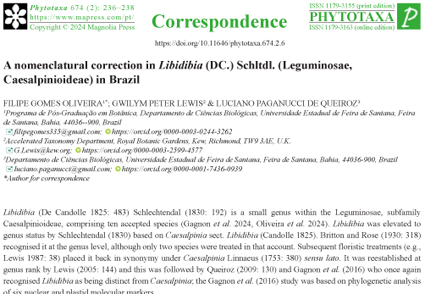Abstract
N/A
References
- Britton, N.L. & Rose, J.N. (1930) Libidibia. In: North American Flora 23 (5). pp. 318–319.
- Bentham, G (1870) Leguminosae, Swartziae, Caesalpineae, Mimoseae. In: von Martius, K.F.Ph. (Ed.) Flora Brasiliensis, vol. 15, part 2.
- De Candolle, A.P. (1825) Prodromus systematis naturalis regni vegetabilis, sive enumeratio contracta ordinum, generum, specierumque plantarum huc usque cognitarum, juxta methodi naturalis normas digestas. Pars 2: Sistens Calyciflorarum ordines X. 644 pp. Treuttel et Würtz, Parisiis. https://doi.org/10.5962/bhl.title.286
- Ferreira, M.R.A. & Soares, L.A.L. (2015) Libidibia ferrea (Mart. ex Tul.) L. P. Queiroz: A review of the biological activities and phytochemical composition. Journal of Medicinal Plants Research 9: 140–150. https://doi.org/10.5897/JMPR2014.5706
- Gagnon, E., Bruneau, A., Hughes, C.E., Queiroz, L.P. & Lewis, G.P. (2016) A new generic system for the pantropical Caesalpinia group (Leguminosae). PhytoKeys 71: 1–160. https://doi.org/10.3897/phytokeys.71.9203
- Gagnon, E., Clark, R.P., Ringelberg, J.J. & Lewis, G.P. (2024) 6. Tribe Caesalpinieae. In: Bruneau, A., Queiroz, L.P., Ringelberg, J.J. (Eds.) Advances in Legume Systematics 14. Classification of Caesalpinioideae. Part 2: Higher-level classification. PhytoKeys 240: 103–145. https://doi.org/10.3897/phytokeys.240.101716
- Glaziou, A.F.M. (1906) Plantes du Brésil central. Bulletin de la Société Botanique de France 53 (Mem. 3b): 158.
- Huber, J.E. (1901) Plantae Cearenses. Bulletin de l’Herbier Boissier, sér. 2, 1: 304.
- Kobayashi, Y.T.S., Almeida, V.T., Bandeira, T., Alcântara, B.N., Silva, A.S.B., Barbosa, W.L.R., Silva, P.B, Monteiro, M.V.B. & Almeida, M.B (2015) Avaliação fitoquímica e potencial cicatrizante do extrato etanólico dos frutos de Jucá (Libidibia ferrea) em ratos Wistar. Brazilian Journal of Veterinary Research and Animal Science, 52: 34–40. https://doi.org/10.11606/issn.1678-4456.v52i1p34-40
- Lewis, G.P. (1987) Caesalpinia. In: Legumes of Bahia. Royal Botanic Gardens, Kew, pp. 38–39.
- Lewis, G.P. (2005) Tribe Caesalpineae. In: Lewis, G.P., Schrire, B., Mackinder, B. & Lock, M. (Eds.) Legumes of the world. Royal Botanic Gardens, Kew, pp. 126–161.
- Linnaeus, C. von (1753) Caesalpinia. In: Species Plantarum, vol. 1. Laurent Salvi, Stockholm, pp. 380.
- Oliveira, F.G., Santos, F.S., Lewis, G.P., Oliveira, R.P. & Queiroz, L.P. (2024) Reassessing the taxonomy of the Libidibia ferrea complex, the iconic Brazilian tree “pau-ferro” using morphometrics and ecological niche modeling. Brazilian Journal of Botany 47 (Spec.): 2024. https://doi.org/10.1007/s40415-024-01011-0
- Queiroz, L.P. (2009) Leguminosas da Caatinga. Universidade Estadual de Feira de Santana, Feira de Santana.
- Queiroz, L.P. (2010) New combinations in Libidibia (DC.) Schltdl. and Poincianella Britton & Rose (Leguminosae, Caesalpinioideae). Neodiversity 5: 11–12. https://doi.org/10.13102/neod.51.3
- Schlechtendal, D.F.L. Von. (1830) Linnaea: Ein Journal für die Botanik in ihrem ganzen Umfange. F. Dümmler, Berlin.
- Turland, N.J., Wiersema, J.H., Barrie, F.R., Greuter, W., Hawksworth, D.L., Herendeen, P.S., Knapp, S., Kusber, W.H., Li, D.Z., Marhold, K., May, T.W., McNeill, J., Monro, A.M., Prado, J., Price, M.J. & Smith, G.F. (2018) International Code of nomenclature for algae, fungi, and plants (Shenzhen Code) adopted by the Nineteenth International Botanical Congress Shenzhen, China, July 2017. Regnum Vegetabile nº 159. Glashütten: Koeltz Botanical Books. Available from: http://www.iapt-taxon.org/nomen/main.php (accessed: 29 October 2024). https://doi.org/10.12705/Code.2018
- Wiersema, J.H., Turland, N.J., Barrie, F.R., Greuter, W., Hawksworth, D.L., Herendeen, P.S., Knapp, S., Kusber, W.-H., Li, D.-Z., Marhold, K., May, T.W., McNeill, J., Monro, A.M., Prado, J., Price, M.J. & Smith, G.F. (eds.) (2024) Appendices I-VII. In: International Code of Nomenclature for algae, fungi, and plants (Shenzhen Code) adopted by the Nineteenth International Botanical Congress Shenzhen, China, July 2017. Available from: https://naturalhistory2.si.edu/botany/codes-proposals/ (accessed 9 September 2024) https://doi.org/10.12705/Code.2018


